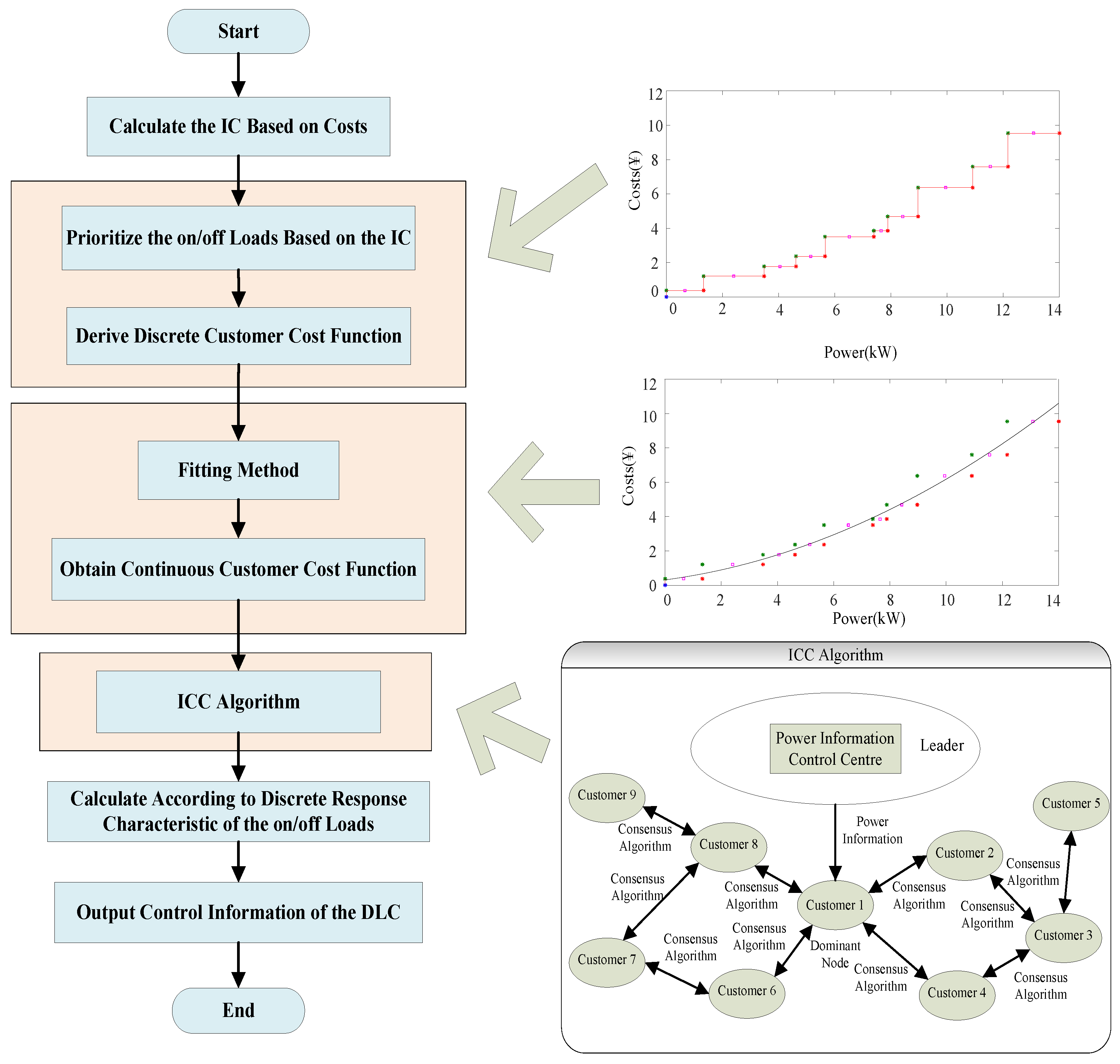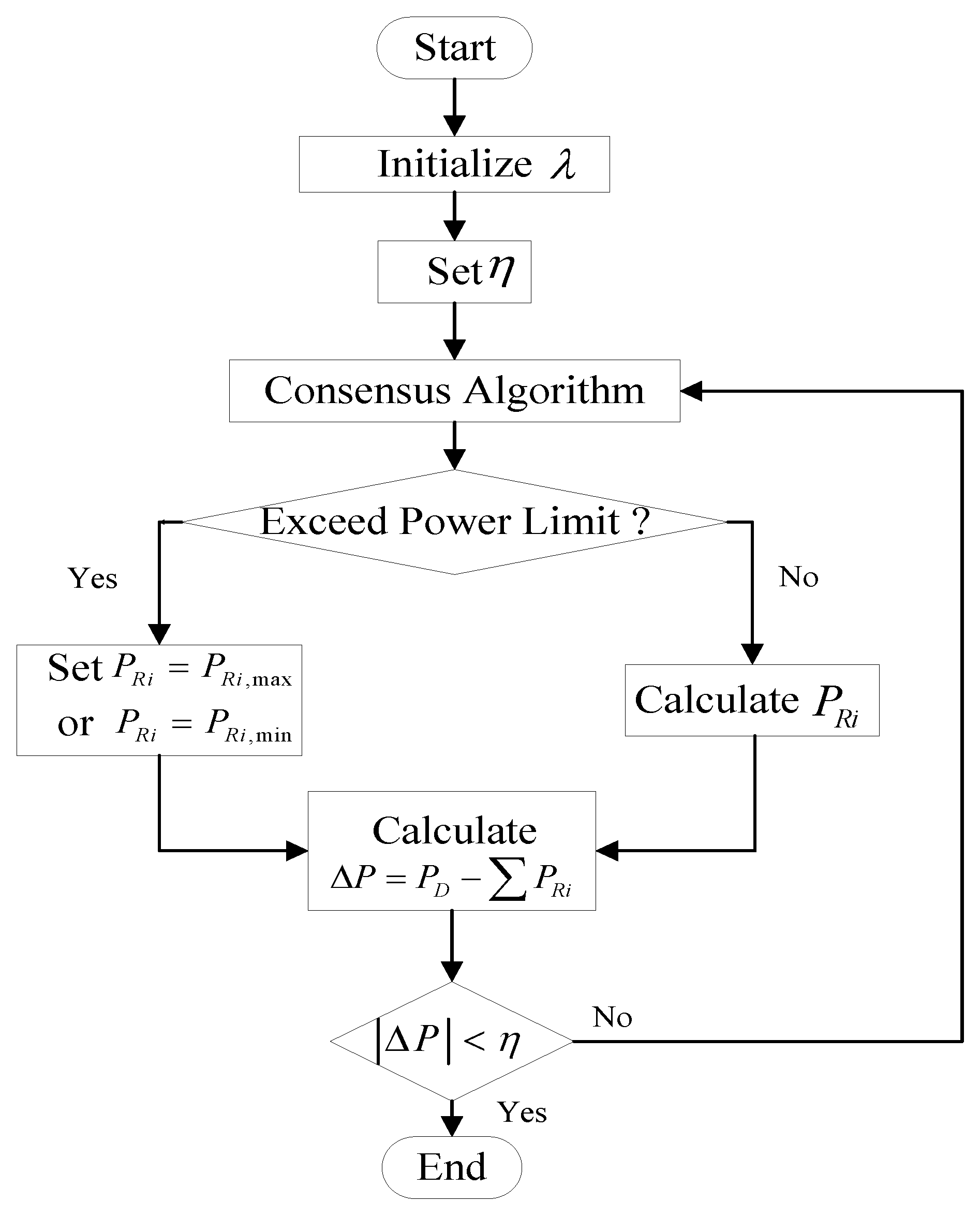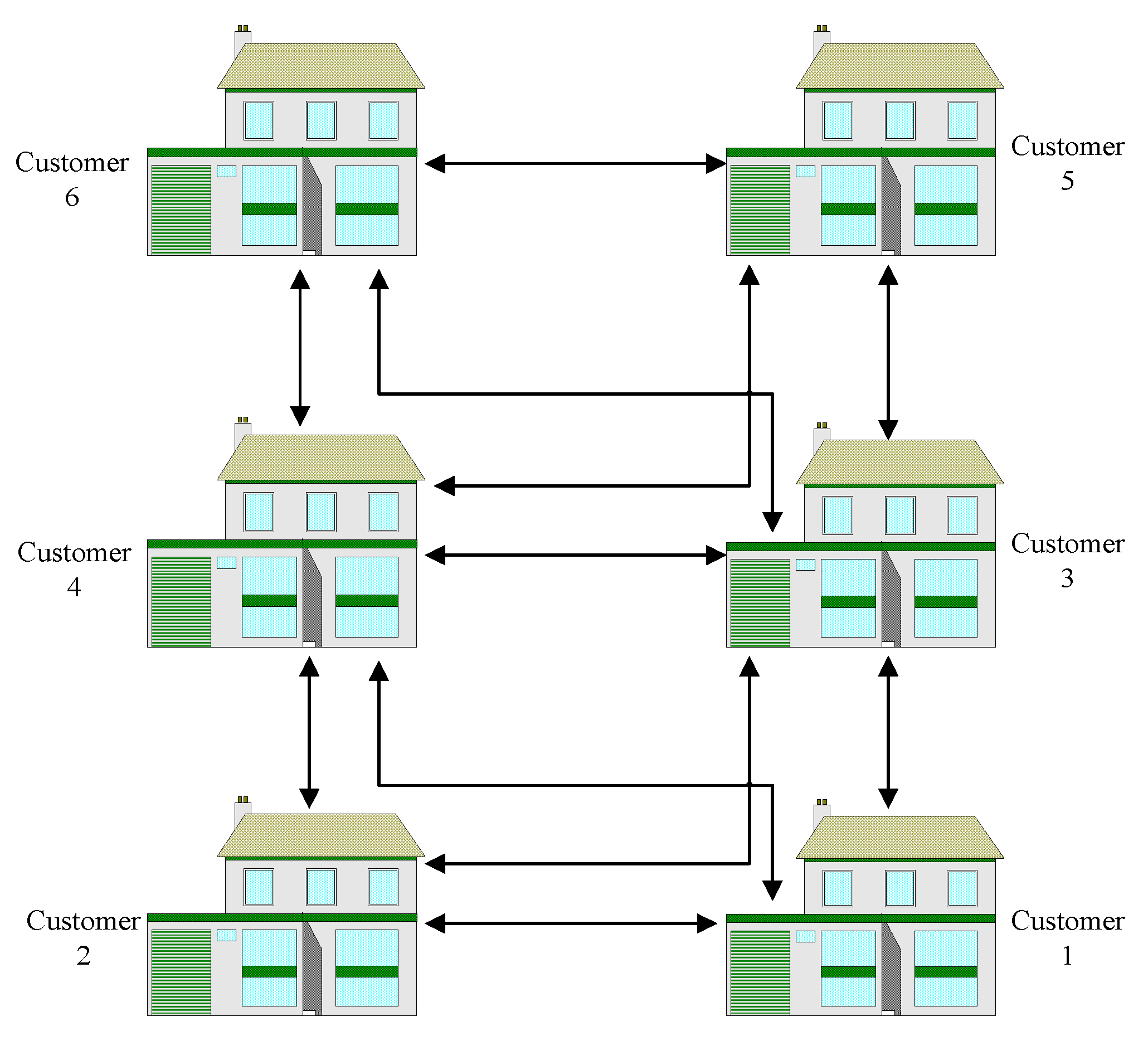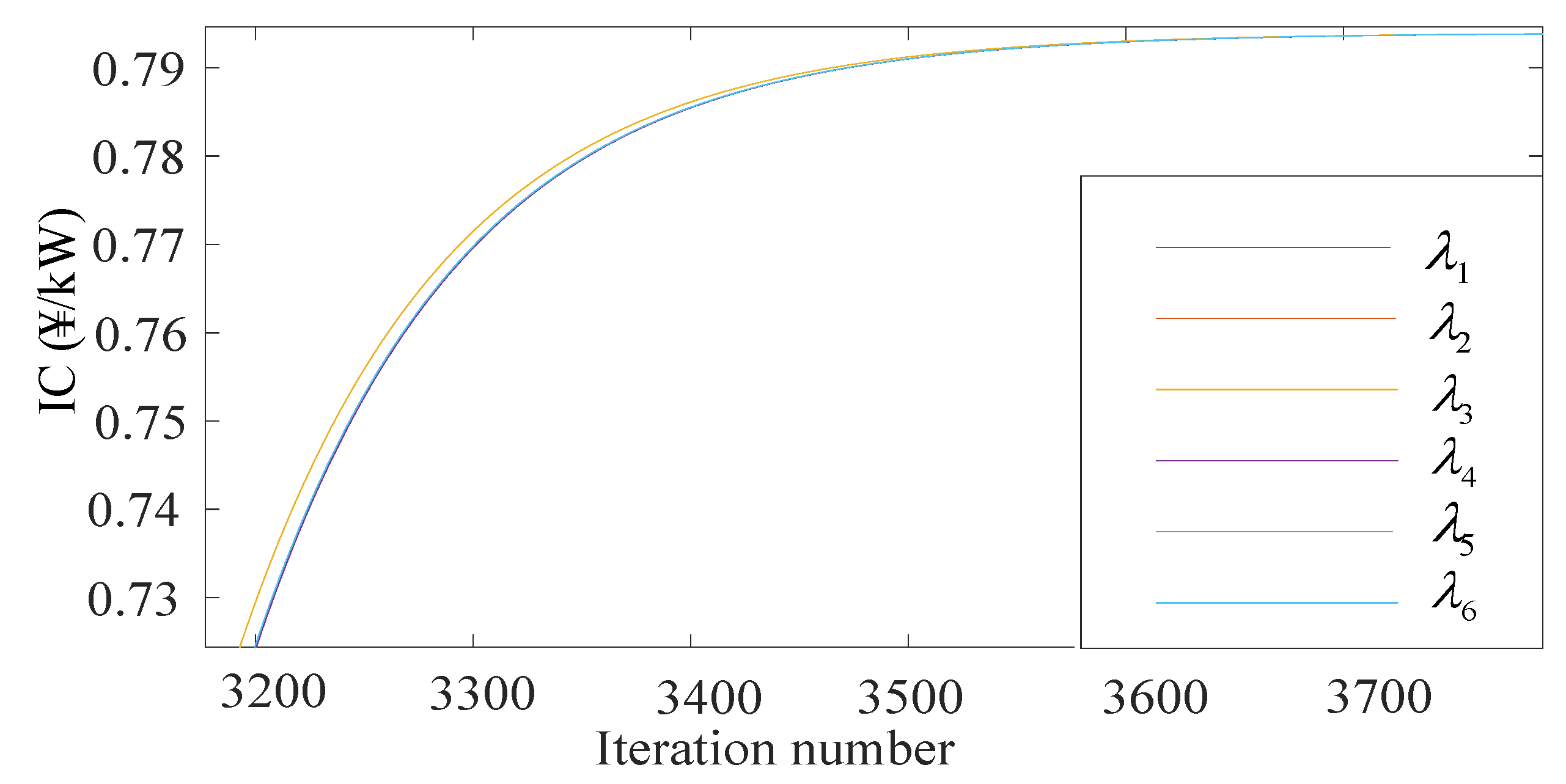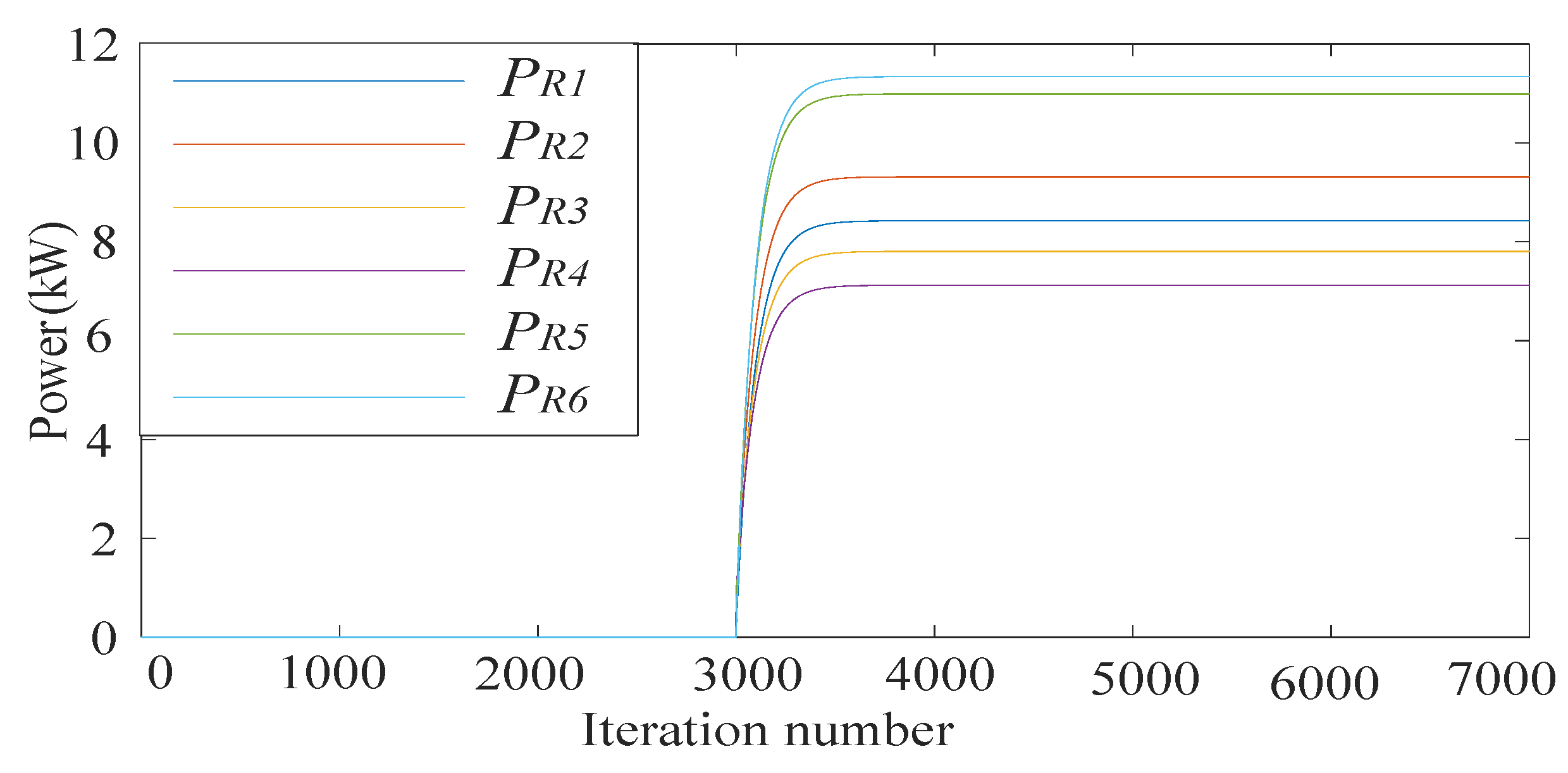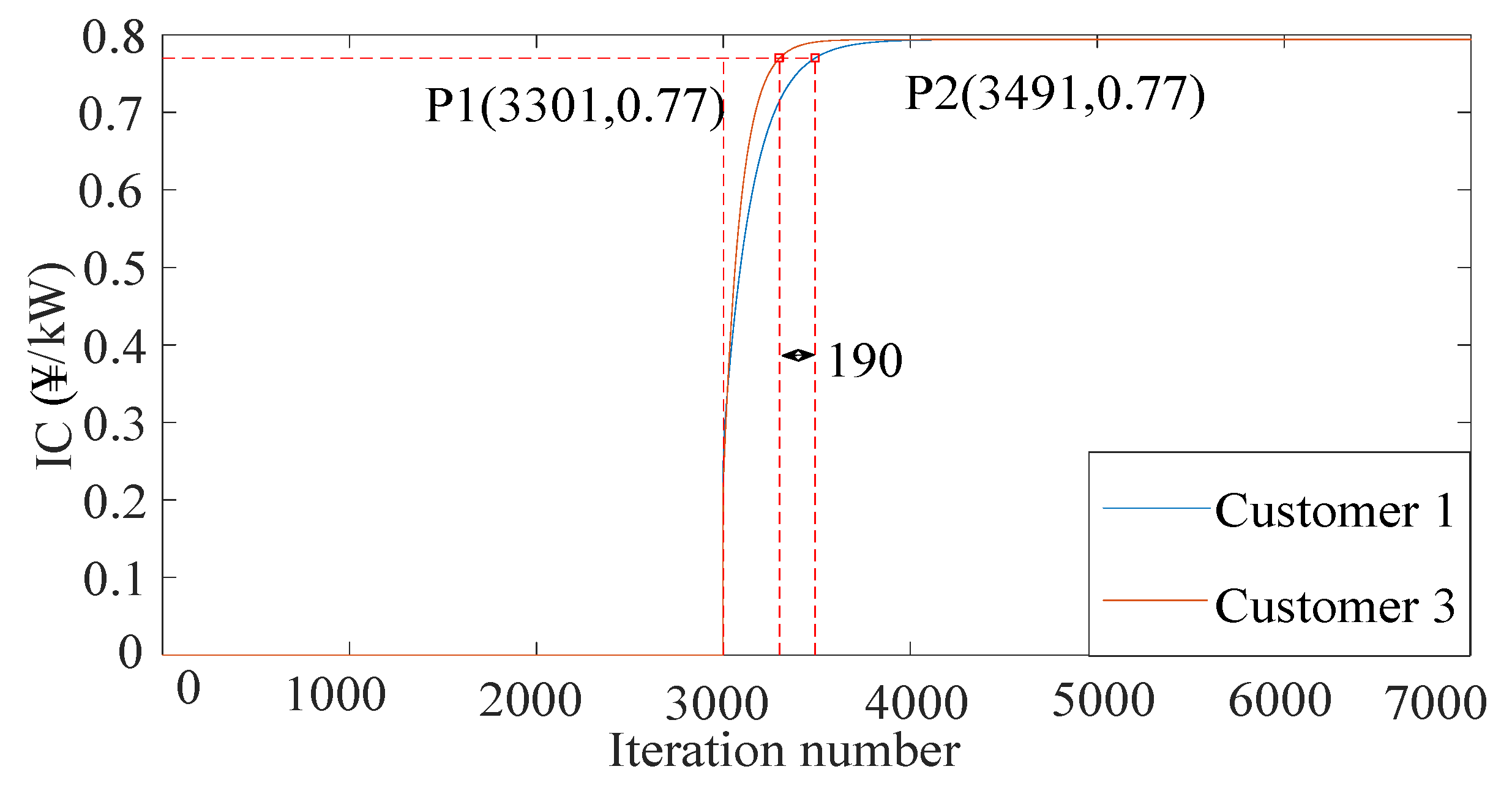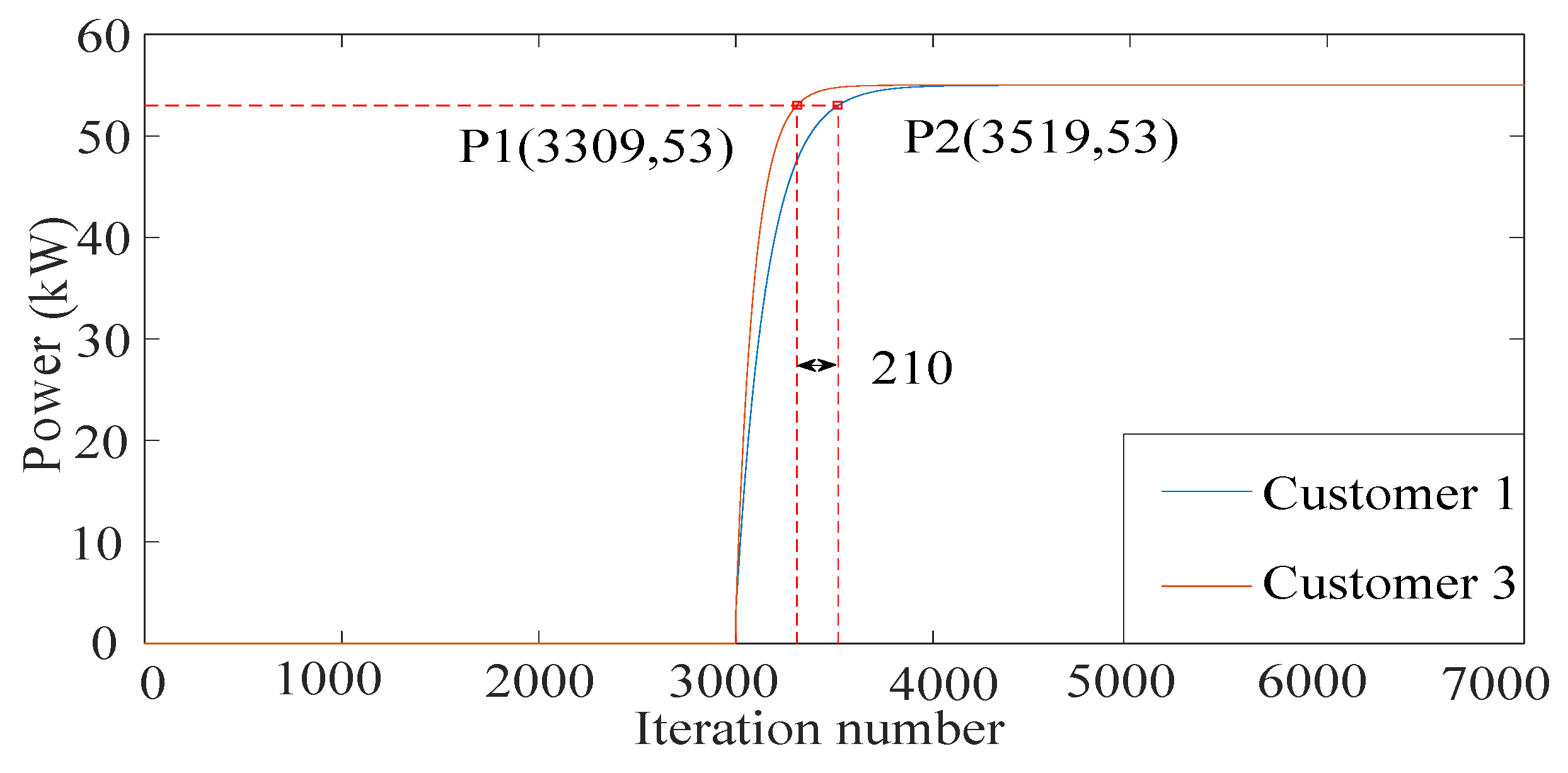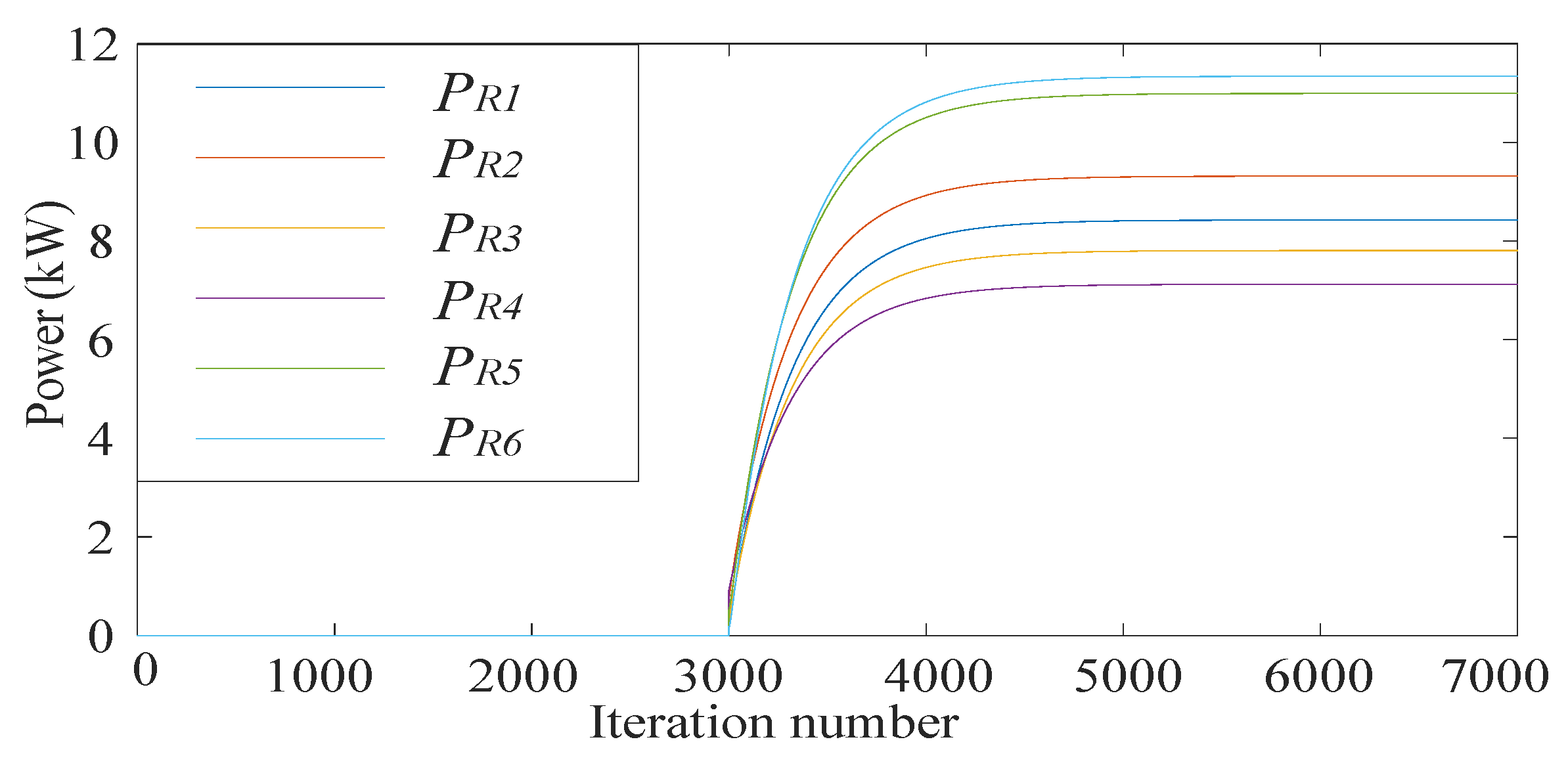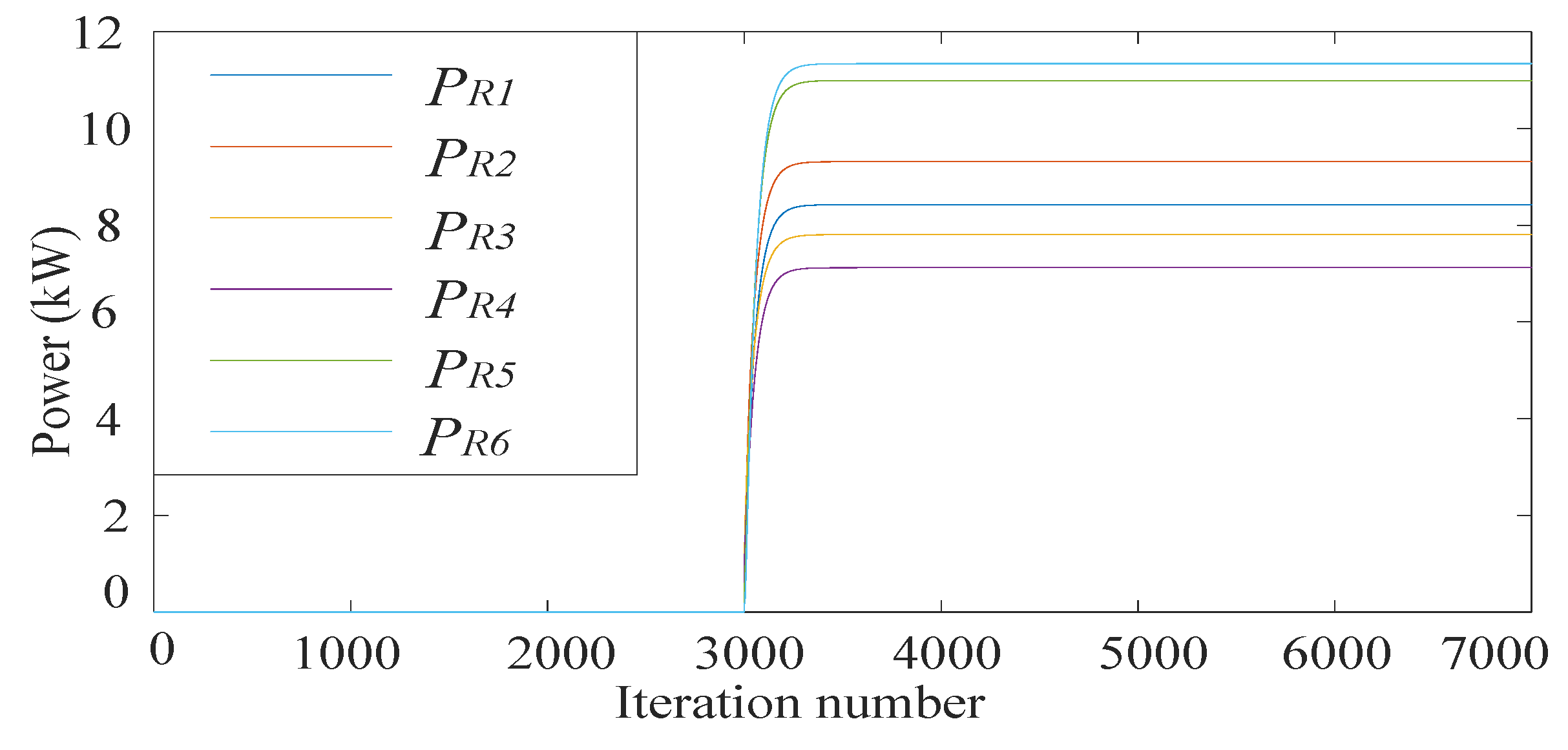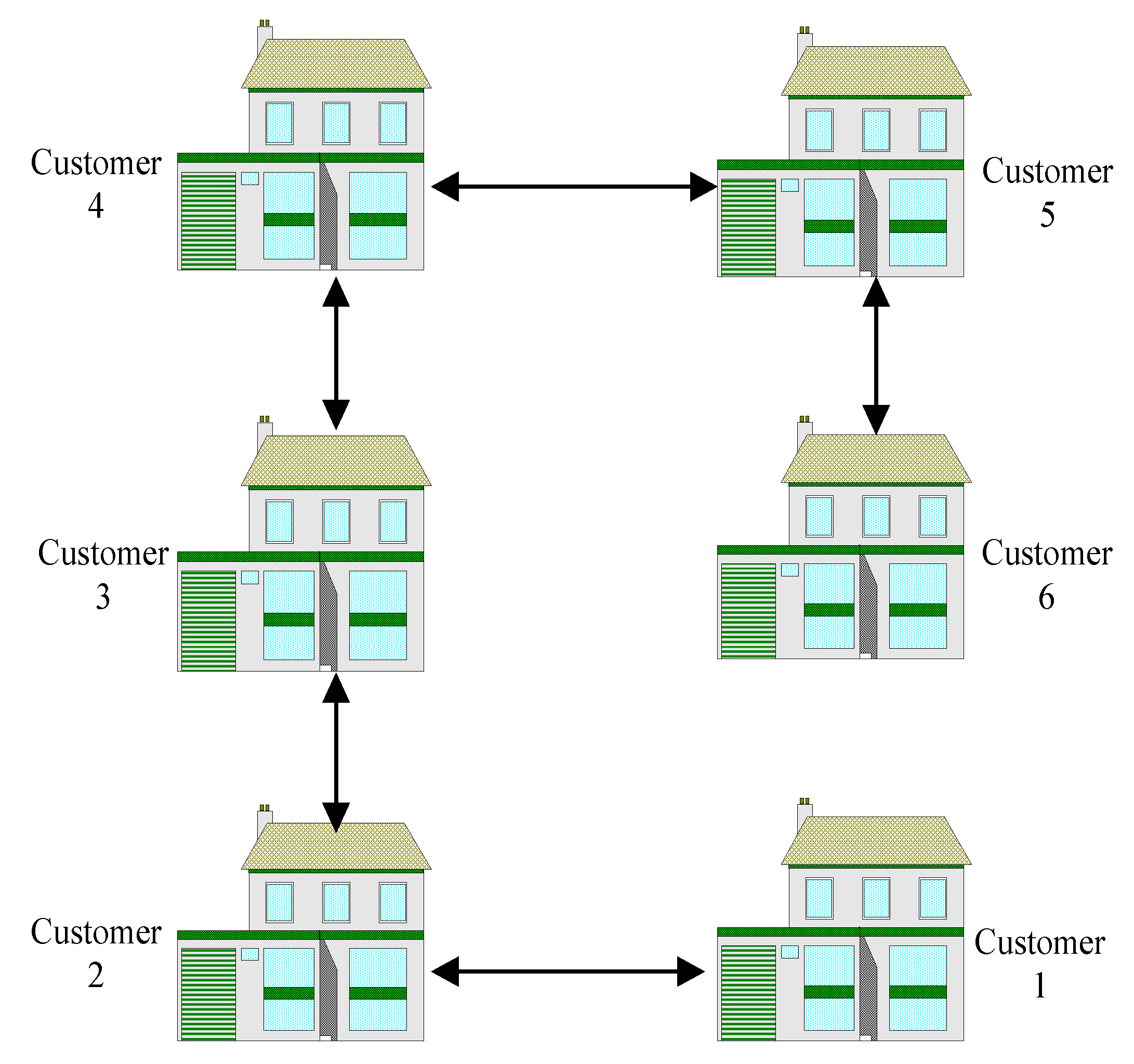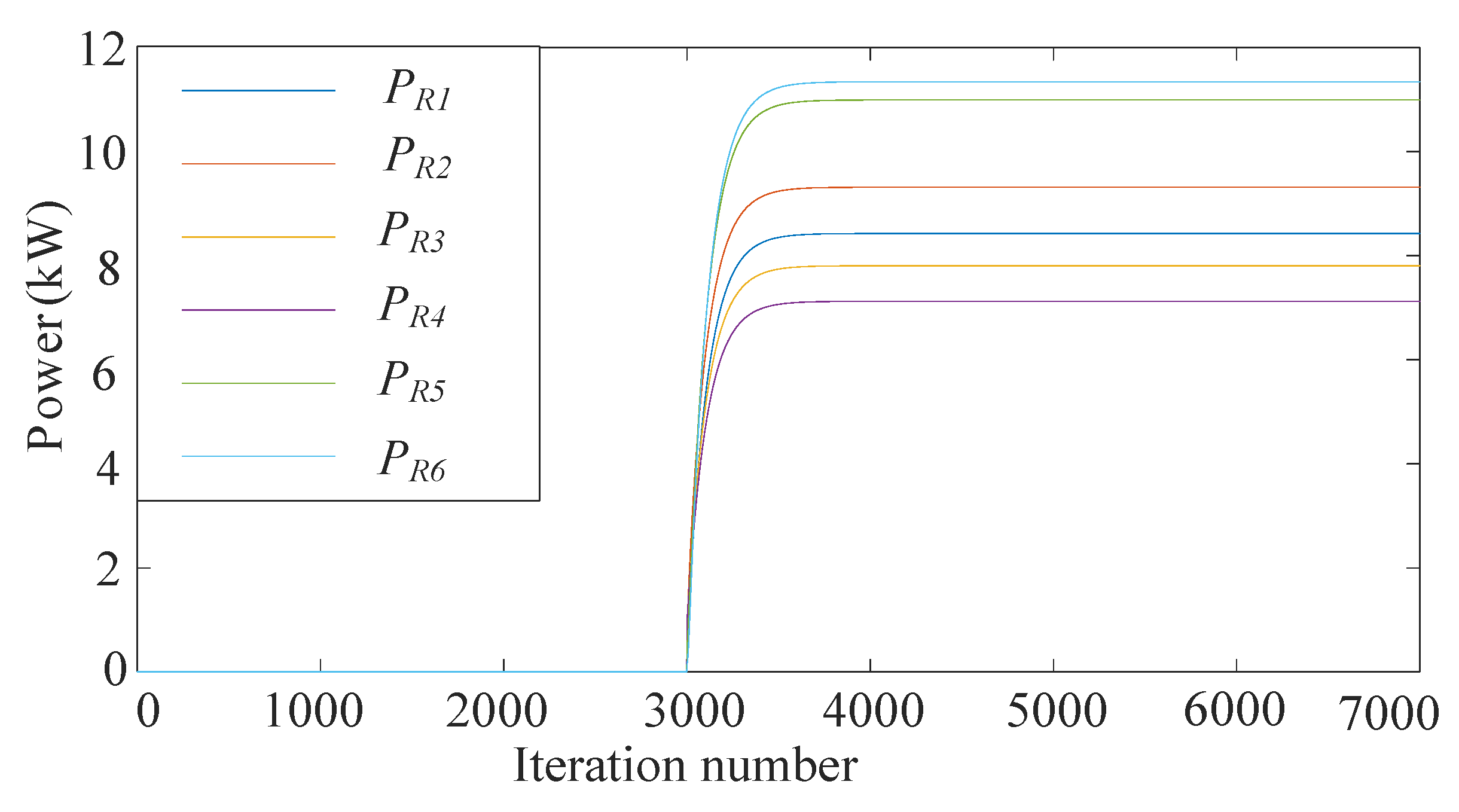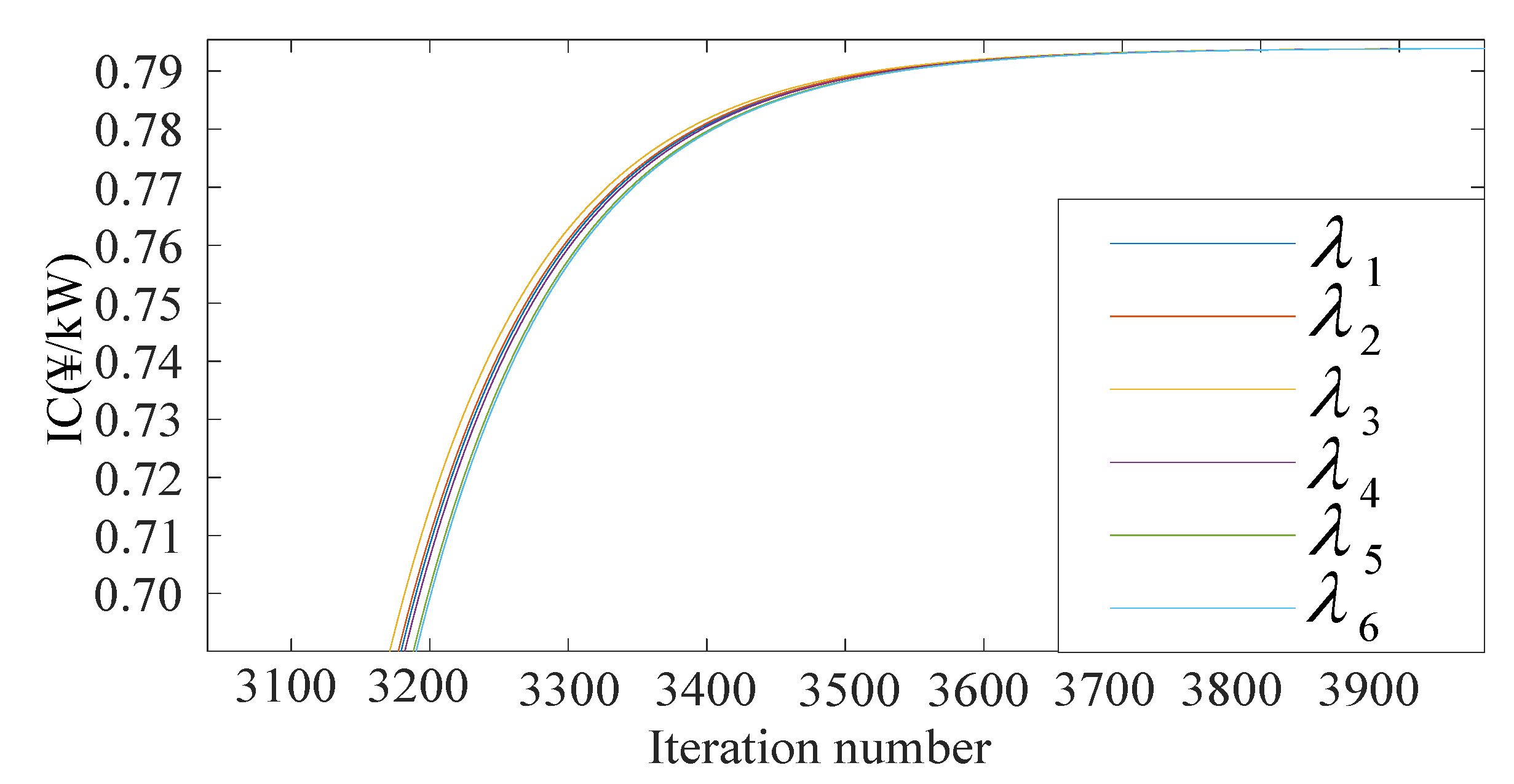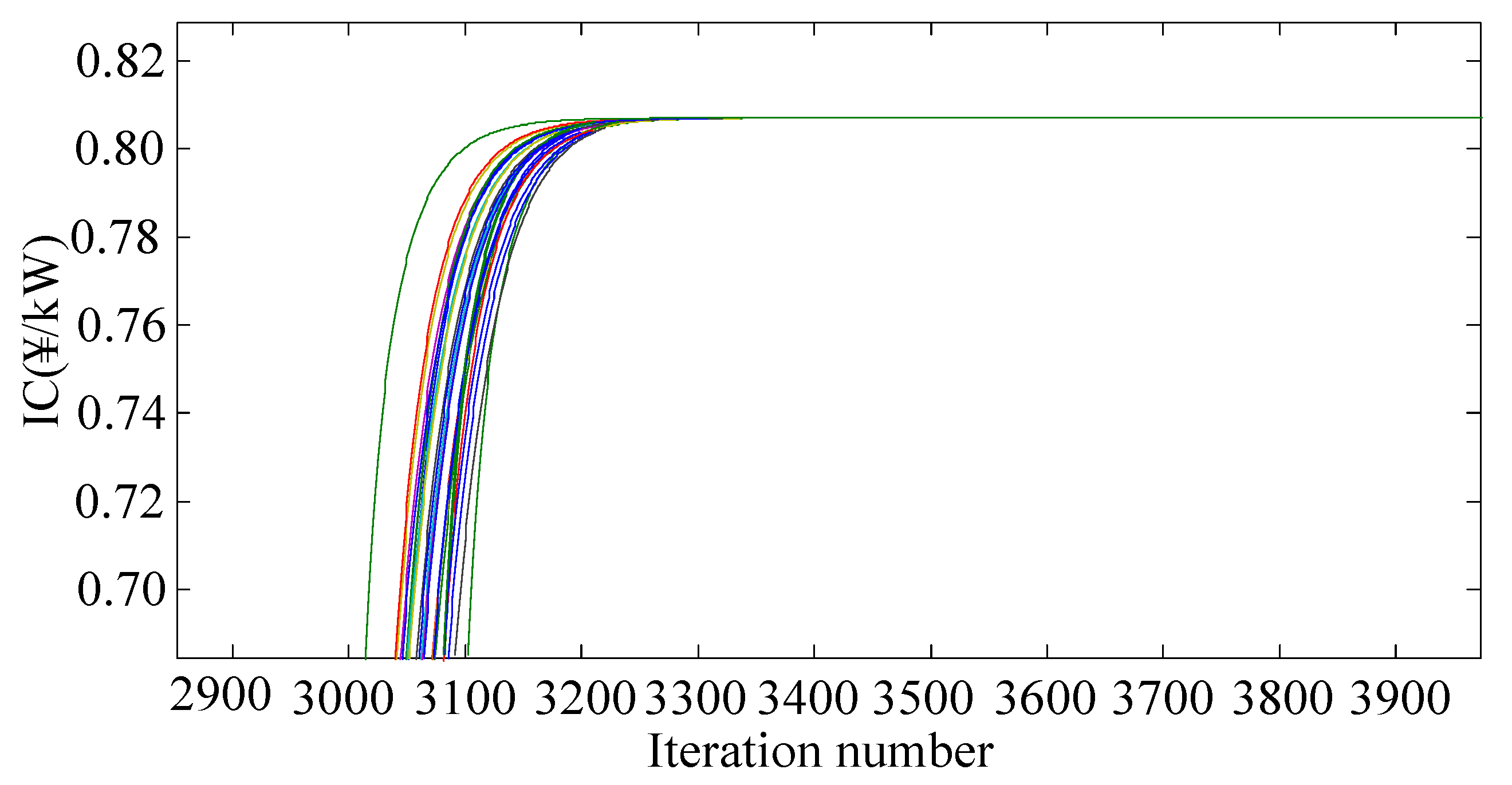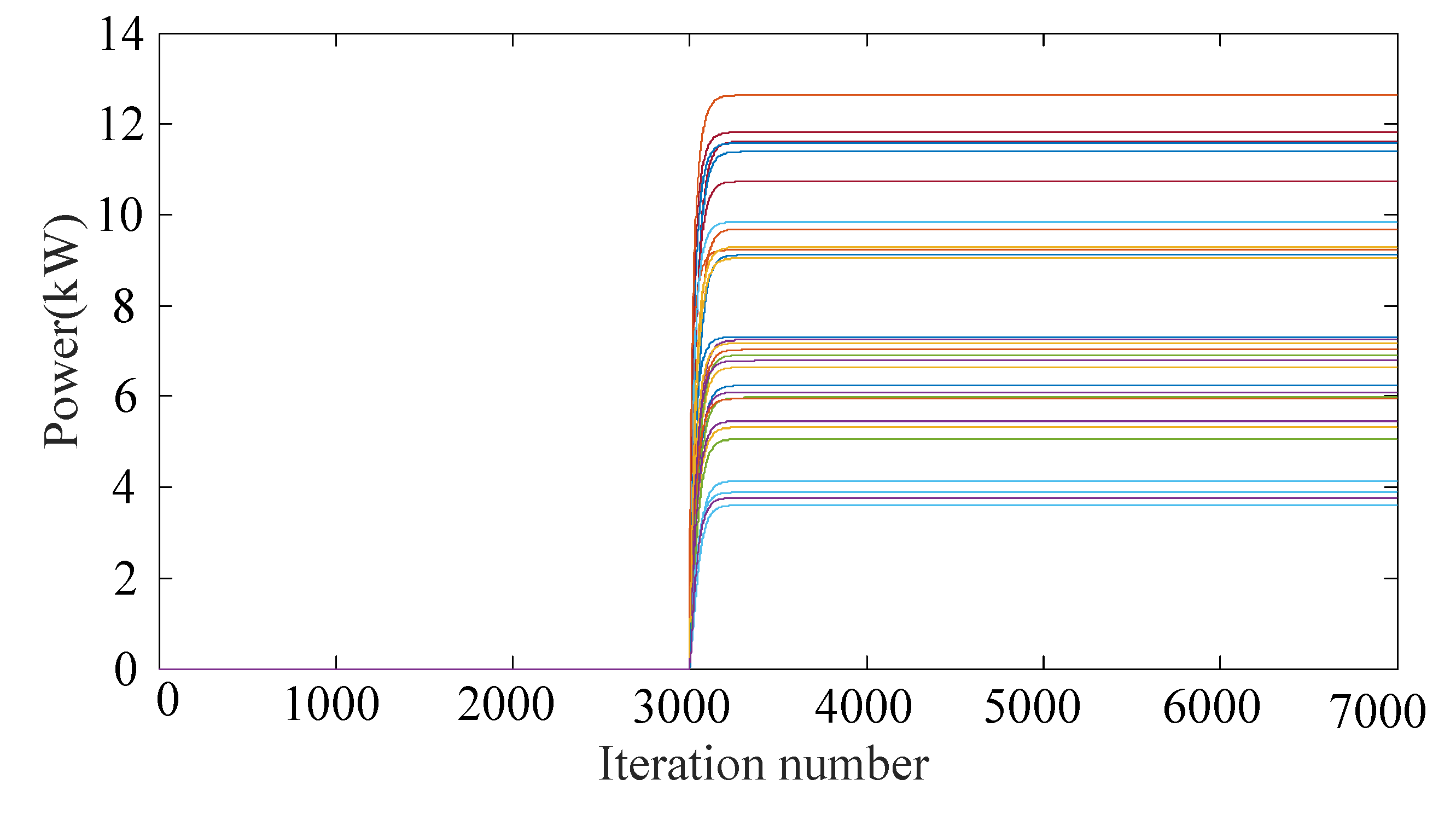1. Introduction
The rapid development of smart electricity utilization techniques has enabled more and more electrical appliances to participate in demand response. Through electricity price or economic incentives, electrical appliances are used to respond to grid dispatching and operation needs, and the stability of power systems is improved [
1,
2,
3].
Incentive-based demand response encourages and guides customers to participate in demand response projects by adopting economic compensation or preferential price policies. Direct load control (DLC) is a common method of demand response that switches on/off the electrical appliances or adjusts the power consumption of the electrical appliances by remote control [
4,
5,
6]. The customers participating in the control will receive economic compensation or electricity price discount. An intelligent home provides more advanced technology for the interaction between customers and the power grid. The control of the electrical appliances is according to the types of electrical appliances, the characteristics of the electrical appliances, and the usage habits of the customers.
The conventional centralized control method requires the control center to operate the entire system. It not only imposes a heavy burden on the control center, but also is unable to guarantee the reliability of the systems. When the number of customers changes, the parameters in the system need to be changed. Compared with the drawbacks of the conventional centralized control method, one of the advantages of the distributed control strategy is that the various parts of the system can be flexibly distributed without centralized management of the control center. Only one or several controlled nodes in the system need to be taken as the dominant nodes to receive control information. Global information is shared between two adjacent nodes, which is beneficial to improve the reliability of the system and avoid communication congestion in the control center. This distributed control strategy is adopted in DLC, and the objective load power of the DLC is allocated to each customer according to the incremental cost consensus (ICC) algorithm, so that the optimal power allocation of the DLC is realized. Therefore, the distributed management and scheduling methods will be able to replace the conventional centralized scheduling mode to a certain extent.
A distributed optimal resource management based on the consensus algorithm is proposed in [
7,
8]. A distributed consensus-based economic dispatch with transmission losses is presented in [
9]. The decentralized control of thermostatic loads for flexible demand response is considered in [
10]. The conventional power generation units for power allocation according to the ICC algorithm under the different conditions of centralized control and distributed control is considered in [
11]. Other research works on consensus control of demand-side resources can be found in [
12,
13,
14,
15,
16,
17]. However, the references mentioned above do not consider comprehensively the load modeling. The managing of the loads only considers the continuous response characteristics of the loads, but does not consider the discrete response characteristics of the on/off loads [
18,
19,
20]. In view of the above problems, this paper proposes a distributed control strategy based on a multi-agent consensus algorithm.
The rest of this paper is as follows:
Section 2 provides the overall framework of the proposed method. The objective function and the ICC algorithm formulations are provided in
Section 3.
Section 4 contains the simulation results and the convergence analysis. Finally,
Section 5 concludes this paper.
2. The Overall Framework of the Proposed Method
The customers participating in the DLC will receive economic compensation or electricity discount. The incremental cost (IC) of each customer can be obtained according to the discrete relationship between customer costs and power. The priority ranking mechanism of the on/off loads is established based on the IC. The discrete cost function can be obtained. By the fitting method, the continuous fitting cost function can be established. Based on the ICC algorithm [
11], the optimal aggregate power can be obtained. According to the priority ranking of the on/off loads of each customer, the objective load power of the DLC is sent to the on/off loads. Therefore, the economic efficiency is improved. The overall flowchart of the proposed method is shown in
Figure 1.
Smart home loads that can participate in the DLC include air conditioners, refrigerators, humidifiers and water heaters, most of which can only control the on/off states and cannot continuously adjust the power. According to the discrete response characteristics of the on/off loads, the priority order of appliances for each customer is ranked from low to high according to the incremental cost of each customer. The customer cost function model is established by a fitting method. According to the relationship between the total objective load power and ICs, the overall customer cost functions can be derived. The customer cost function presents discrete characteristics due to the discrete response characteristics of the on/off loads. The on/off loads sequentially perform full load power accumulation according to the priority order, and the customer costs do not change until the full power of the next electrical appliance is reached. Therefore, the relationship between the customer costs and the load power is a ladder diagram, and the customer costs change only when the response load power reaches the accumulated value of the full load power of the appliances. The continuous fitting cost function can be obtained by the fitting method.
3. ICC Algorithm Formulations
The relationship between the customer costs and the load power can be obtained by the fitting method as a quadratic function:
where
denotes the costs of the customer
and
denotes the output power of the customer
.
The total costs of customers participating in the DLC are written as following:
with the power balance constraint and customer power capacity limit constraint:
where
denotes the objective load power of the DLC. The objective of optimal power allocation is that the economic efficiency can be improved under the conditions of Equations (3) and (4).
In the ICC algorithm, the definition of IC for each customer is defined as following:
Selecting IC (also known as
) as the consensus variable, and according to the first-order discrete consensus algorithm [
21], the updating of
for the non-dominated nodes can be formulated as following:
where
is the
entry of the row-stochastic matrix
.
It can be known from Equation (5) that the current power information of each customer can be obtained by the IC of the customer as following:
In order to satisfy the power balance constraint (3), define
to indicate the mismatch between the objective load power of the DLC and the total output power of the customers as following:
After introducing the mismatch, the update rule for the customer located at the dominant node is obtained as following:
where
is the convergence coefficient, which controls the convergence speed of the dominant node. The increases or decreases of
will follow the sign of
. If
, it means that the DLC needs to reduce the objective load power, so the current
should be decreased; and vice versa.
By following the update rules described by Equations (6) and (9), all the customers are able to converge to a common IC asymptotically.
According to the Equations (4) and (7), the customer power capacity limit constraint also needs to be considered as following:
Equations (5)–(9) are mathematical representations of the ICC algorithm, Equation (5) is used for consensus variable calculation, and Equations (6) and (9) represent consensus algorithm iterative processes.
Figure 2 is a flowchart which represents the procedure of the ICC algorithm. The dominant node needs to make an adjustment for the power balance constraints as shown in Equation (3). If the total output power of customers reaches the objective load power of the DLC, the consensus algorithm is stopped, and each customer outputs power according to the current information. Otherwise, the consensus algorithm is continued. Thus, the optimal power allocation of customers can be realized based on the ICC algorithm [
11]. According to the priority ranking of the on/off loads of each customer, the objective load power of the DLC is sent to the on/off loads.
4. Simulation Results and Convergence Analysis
4.1. Optimal Power Allocation of Smart Home Appliances
In this section, we take a small system of six customers for case study. The network topology of the system is shown in the
Figure 3. Each customer is connected with the rest of the customers through power lines and communication links. The electrical appliances used by each customer include air conditioners, water heaters, refrigerators and so on. In this paper, the on/off loads participating in the DLC are used as case studies, and they are sorted according to the priority order of different electrical appliances of each customer. According to the priority order of these home appliances, the load power of the higher priority is more likely to be activated.
Assume that the power capacity parameters of the home appliances of the customers are as shown in
Table 1. The priority order of appliances is Appliance 1 to Appliance 10.
Assume that the customer compensation for participating in the DLC is randomly distributed between 0.1–1.5 ¥/kW according to the types of appliances. Considering the discrete response characteristics of the on/off loads, the priority ranking is implemented, and the customer cost function can be established by the fitting method. The parameters of six customer cost functions are shown in
Table 2.
Taking Customer 3 as an example, the cost function is drawn by the curve fitting method. The relationship between the customer costs and the load power is shown in
Figure 4, and the fitting function is obtained as following:
In this example, it is assumed that the initial objective load power is 0. When the objective load power of the DLC is increased to 55 kW, the customers achieve optimal power allocation through the distributed control method. Customer 3 is selected as the dominant node with a fixed step size of 0.0002 s and a convergence coefficient of
= 0.0005. As shown in
Figure 5, all the customers are able to converge to the optimal IC asymptotically under the neighbor interconnection topology. This also proves that the distributed control strategy is able to make each customer get the global state information through the local information exchange. As shown in
Figure 6, each customer in the system achieves the optimal power allocation according to the distributed control strategy. As the simulation result shows in
Figure 7, when the objective load power of the DLC increases from 0 to 55 kW, the total output power of the customers reaches the objective load power of the DLC after the iteration process.
As shown in
Table 1, the power is allocated according to the priority order of appliances of each customer. When the objective load power is increased to 55 kW, the actual working status of the home appliances of each customer is shown in
Table 3.
In order to verify the economic efficiency of the proposed strategy, the following three scenarios are compared.
Scenario 1: The distributed control strategy is used for power allocation of customers based on the ICC algorithm.
Scenario 2: The objective power of the DLC is allocated proportionally according to the power capacity of each customer.
Scenario 3: The objective power of the DLC is equally sent to each customer.
Scenario 2 and Scenario 3 can be realized through non-IC-based consensus control. The consensus variable is the objective power of the DLC.
The total costs of customers in different scenarios are shown in
Table 4. It is able to be found that the total costs to customers is the minimum in Scenario 1. It also proves that the economic efficiency is improved based on the ICC algorithm through the distributed control strategy.
4.2. Convergence Analysis Based on ICC Algorithm
In the following, the ICC-based distributed control method is tested. In this section, we focus on convergence analysis based on the ICC algorithm. There are several factors that can affect the convergence rate of the ICC algorithm, such as the relationship between communication topology and convergence speed. We can use the node centrality measurement to make the dominant node election. We also discuss the performance of the ICC algorithm under large-scale systems in this section.
In order to verify the location of the dominant node, which can affect the convergence rate, Customer 1 is selected as the dominant node of the system, and this is compared with the case where Customer 3 is the dominant node. The simulation results are shown in
Figure 8 and
Figure 9.
Figure 8 and
Figure 9 show that when the Customer 3 is selected as the dominant node, the convergence rate (0–96%) of the average value of ICs is 190 iterations faster than selecting Customer 1 as the dominant node, and the convergence rate (0–96%) of output power of customers is 210 iterations faster. The location of the dominant node is a significant factor influencing the convergence rate of the ICC algorithm.
Table 5 shows the response time of the system when Customers 1–6 are selected as the dominant node, respectively. It can be found that the more adjacent nodes of the selected dominant node exist, the faster the convergence rate of the system. It is a typical problem for the type of algorithm to determine how to select the appropriate node as the dominant node to achieve a faster convergence rate. We can use the existing node centrality indices for dominant node selection, such as degree centrality and closeness centrality. We can use these centrality indices as indicators for the selecting the dominant node.
The ICC algorithm can handle a wide range of communication networks, so the topology of the communication network and the location of the dominant node can affect the convergence rate. As mentioned in the previous section, the dominant node will increase or decrease the group IC based on the mismatch . Thus, the convergence rate can be controlled by adjusting the convergence coefficient .
Figure 10 and
Figure 11 show two different convergence rates using different values for
. Using the same step size, the system with
= 0.001 converges faster than the system with
= 1/6000. Thus, the larger
is related to a faster convergence speed. However, we should also consider its influence on system stability in practical working conditions.
As the previous section mentioned, the convergence rate is based on the topology of the system’s communication network. Consider the six-customer system with a chain connection, which is shown in
Figure 12 and a neighbor interconnection, which shown in
Figure 3.
The Laplacian graphs of neighbor interconnection topology and chain connection topology are obtained as following:
Figure 5,
Figure 6,
Figure 13 and
Figure 14 show the simulation results under different communication topologies when Customer 3 is selected as the dominant node, and chain connection topology has a faster convergence rate than neighbor interconnection topology. This result suggests that the topology of the system’s communication network can affect the convergence rate of the ICC algorithm.
In general, when the number of nodes increases, the ICC algorithm needs more iterations to reach a consensus. The convergence rate under a different number of nodes is a very important performance measure. We will discuss the performance of the ICC algorithm under a larger-scale system. Take a community with 32 residential customers, as shown in the
Figure 15 as an example. As shown in
Figure 16, when the objective load power of the DLC increases from 0 to 300 kW, all customers are able to converge to the optimal IC asymptotically based on the ICC algorithm. The optimal power allocation of customers is realized as shown in
Figure 17. The ICC algorithm can handle a larger scale of communication network. Hence, the ICC algorithm is able to handle a relatively large number of customers in a reasonable period of time.
5. Conclusions
This paper focuses on the distributed control strategy of domestic appliances for demand response. The contributions of this paper can be summarized as following:
Based on the ICC algorithm, this paper proposes a distributed control strategy to realize optimal power allocation of customers.
The discrete cost function can be obtained through calculating a fitting function according to the priority ordering, and the ICC algorithm is implemented for the on/off loads.
With the rapid development of the smart grid, the future power system will develop toward larger scales and wider ranges. Therefore, the distributed control strategy will certainly play a greater role in the future. Further research will mainly consider the uncertainty of the response of the on/off loads. At the same time, it is necessary to have a more realistic experiment platform to conduct more in-depth research and verification, so that the distributed control strategy will be further verified.
